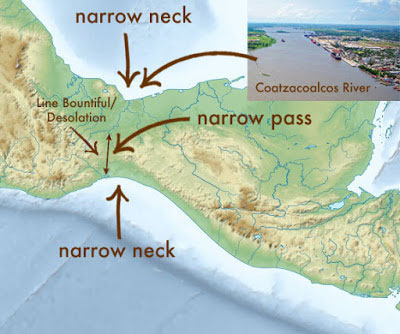 |
| The Book of Mormon never says it is a day and a half's journey from the East Sea to the West Sea. Read it again. |
For example, "up" means up in elevation and "down" means down in elevation (never up north or down south).
"Northward" means "northeast or northwest" and "north" or "northern parts" means due north or nearly in the direction of cardinal north. "North" is not interchangeable with "northward."
It is very easy to inject our own language's idiosyncrasies into the Book of Mormon language. For this reason, one of the most misunderstood verses in the Book of Mormon is Alma 22:32 where it says:
"And now, it was only the distance of a day and a half’s journey for a Nephite, on the line Bountiful and the land Desolation, from the east to the west sea; and thus the land of Nephi and the land of Zarahemla were nearly surrounded by water, there being a small neck of land between the land northward and the land southward."Most people will paraphrase this as saying, "it takes a Nephite only a day and a half to journey from the EAST SEA to the WEST SEA." But read it again and you'll see that it doesn't say FROM THE EAST SEA.
It actually says "it was only the distance of a day and a half’s journey for a Nephite, on the line Bountiful and the land Desolation, from the east to the west sea" - or in other words - it was a journey of a day and a half from EASTERN END OF THE LINE that separates Bountiful and Desolation, passing through the narrow pass TO THE WEST SEA. Simply put it was a day and a half walk from one end of that boundary line to the other end, which ended at the west sea.
This fact is further clarified in Hellman 4:7 where it says:
And there they did fortify against the Lamanites, from the west sea, even unto the east; it being a day's journey for a Nephite, on the line which they had fortified and stationed their armies to defend their north country.
Note again, it does NOT say "east sea." The Book of Mormon language is precise. If Mormon meant to say "east sea" he would have said "east sea." Instead, he says that it is a day and a half journey from one end of the line to the other. From the west sea to the easternmost terminus of that defensive boundary line. The rest of the isthmus was impassable due to the the Coatzacoalcos River, a river that is navigable for large ocean-going vessels for almost 2/3rds of its length. That is almost halfway through the Isthmus of Tehuantepec. This is easily the reason for it being described as "the place where the sea divides the land." Ether 10:20
Too many Book of Mormon Geography models have run way off course because of the simple assumption that you have to find a REALLY narrow neck of land, from sea to sea, to make this verse fit.
This belief has been prevalent for so long that, unfortunately, the Spanish version of the Book of Mormon has been incorrectly translated to say, "from the sea of the east to that one of the west" OR "desde el mar del este al del oeste." See for yourself:
Instead, it should be translated literally, like this: "...era solo la distancia de un día y medio de viaje para un nefita, en la línea de Abundancia y la tierra de Desolación, desde el este al mar oeste..."Alma 22:32 Pues bien, la distancia no era sino de día y medio de viaje para un nefita, por la línea de Abundancia y la tierra de Desolación, desde el mar del este al del oeste; y así la tierra de Nefi y la tierra de Zarahemla casi se hallaban rodeadas de agua, y había una pequeña lengua de tierra entre la tierra hacia el norte y la tierra hacia el sur.
"Entire Hemisphere" Model
 |
| "Andes Sunken Continent" Model |
Curiously, however, the supporting verse in Helaman 4:7 is translated correctly:
Y allí se fortificaron contra los lamanitas desde el mar del oeste hasta el este; y esta línea que habían fortificado, y en la cual habían apostado sus tropas para defender su país del norte, era una jornada de un día para un nefita.There is also confusion with the term "narrow pass" or "narrow passage." Many people assume it is another way to say "narrow neck." But that is not the case.
 |
| "American Heartland" Model |
This confusion is understandable because the "narrow pass" just happens to be in the "narrow neck." Mesoamerica has a narrow passage in the same place as a narrow neck. There is no other place in the Americas that fits BOTH requirements. And the distance that a Nephite can travel through the pass fits the Book of Mormon's description and the actual geography of the Isthmus of Tehuantepec.
 |
| "Isthmus of Rivas" Model |
 |
| "What the Heck Let's Just Make Anything Up" Model |
 |
| "Baja California" Model |
